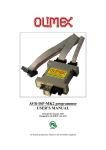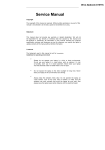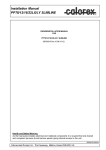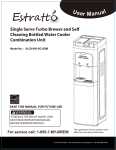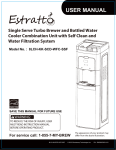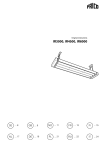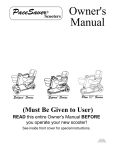Download Maruyama BL85 Specifications
Transcript
BL85 BACKPACK BLOWER TABLE OF CONTENTS Foreword ··························································1 Safety symbols·················································1 Specifications ···················································4 Assembly instructions ······································4 Before operation···············································5 Operating instructions ······································8 Regular maintenance·····································10 Storage···························································11 Emission control information························· 12 FOREWORD This Owner’s/Operator’s Manual is designed to familiarize the operator with the various features and component parts of the equipment and to assist you with the assembly, operation and maintenance of your new Backpack Blower. It is essential that any operator of this Backpack Blower product reads and understands the contents of this manual before using the Backpack Blower. Important safety instructions will be identified by the following safety symbol: Failure to comply with the instructions in this manual may result in serious injury or death. For additional assistance, contact any local authorized Maruyama dealer. MANUAL SAFETY SYMBOLS Throughout this manual and on the product itself, you will find safety alerts and helpful, information message preceded by symbols or key words. The following is an explanation of those symbols and key words and what they mean to you. This symbol accompanied by the words WARNING and DANGER calls attention to an act or condition that can lead to serious personal injury to operator and bystanders. English —1— MARKING ④ ① ② ③ ⑤ ① MODEL NAME ② SERIAL No. ③ C-Tick LABEL ④ WARNING LABEL ⑤ CAUTION LABEL Warning label • Always remove dirt or mud to make the indications legible. • The following alarm labels are attached. Alarm label Read operation manual thoroughly. Make sure you read the operation manual thoroughly prior to use. Prohibition of fire Don't put a naked flame close to a place where supplying fuel or doing maintenance. Wear a protector. Wear protectors such as hat, safety glasses, ear plugs during work. Cautions for exhaust gas. Take care not to breathe in exhaust gas from the engine. Cautions for high temperatures Muffler of engine, fin of cylinder, etc. are at high temperatures. Don't touch them. —2— English WARNING 1. 2. 3. 4. 5. 6. 7. 8. 9. 10. 11. 12. 13. 14. 15. 16. 17. 18. 19. 20. 21. 22. 23. Read and understand this Owner's/Operator's Manual before using the power blower. Be thoroughly familiar with the proper use of the power blower. Never allow children to operate the power blower. It is not a toy. Never allow adults to operate the unit without first reading the Owner's / Operator's Manual. Become familiar with the controls and know how to stop the engine quickly. Always use eye protection and hearing protection. Keep the area of operation clear of all persons, particularly small children and pets. Do not point the blower nozzle in the direction of people or pets. Never operate a power blower when you are fatigued. Never operate a power blower without proper guards or other protective safety devices in place. Dress properly; do not wear loose clothing or jewelry that can be caught in moving parts. Always wear substantial footwear, long pant, and long sleeved shirt. Gasoline is highly flammable; handle it carefully. A. Do not smoke while handling gasoline. B. Use an approved fuel container for storing the gasoline/oil mixture. C. Do not fill the fuel tank when the engine is hot or running D. Fill the fuel tank outdoors and only up to one-half inch from the top of the tank. Do not fill the filler neck. E. Wipe away any spilled gasoline before starting the engine. Always be sure of your footing; keep a firm hold of the blower pipes, and walk, never run while operating a power blower. Use the correct accessories. Do not use the power blower for any job except that for which it is intended . Keep all fasteners tight and be sure the power blower is in safe working condition. Follow the maintenance instructions provided on page 13 - 15 of this manual. Do not put hands or feet near or under the rotating parts. Keep clear at all times. If the power blower should start to vibrate abnormally, stop the engine immediately and check for the cause. Vibration is generally a warning of trouble. Avoid using the power blower near rocks, gravel, stones and similar matter in order to avoid dangerous flying debris. Use the power blower only in daylight or good artificial light. Do not allow bystanders in work area. Do not operate without guard(s) in place. Do not operate in unventilated area. To reduce the risk of injury associated with the inhalation of dust, use a face filter mask in dusty conditions. To reduce the risk of injury associated with contacting rotating part, stop the engine before installing or removing attachments. To reduce the risk of fire and burn injury: -Move at least 10ft (3m) away from the fueling point before starting engine. -Always store gasoline in approved container. Operating techniques A. B. C. D. E. F. G. H. I. J. English Operate power equipment only at reasonable hours - not early in the morning or late at night when people might be disturbed. Comply with times listed in local ordinances. Usual recommendations are 9:00 am. to 5:00 p.m., Monday through Saturday. To reduce noise levels, limit the number of pieces of equipment used at any one time. To reduce noise levels, operate power blowers at the lowest possible throttle speed to do the job. Check your equipment before operation, especially the muffler, air intakes, and air filters. Use rakes and brooms to loosen debris before blowing. In dusty conditions, slightly dampen surfaces when water is available. Conserve water by using power blowers instead of hoses for many lawn and garden applications, including areas such as gutters, screens, patios, grills, porches, and gardens. Watch out for children, pets, open windows, or freshly washed cars, and blow debris safely away. Use the full blower nozzle extension so the air stream can work close to the ground. After using blowers and other equipment, CLEAN UP! Dispose of debris in trash receptacles. —3— SPECIFICATIONS Models BL85 14.4 x 19.1 x 20.1 in. (365 x 485 x 535 mm) Dimensions L x W x H Standard Dry Weight 21.1 lbs. (9.6 kg) Engine Type Kawasaki/2-Stroke Air cooled TK65 for EPA Displacement Ignition System Carburetor Fuel Tank Capacity 64.7 cc Electric All position diaphragm 0.5 gal (2.0 lit) 50:1 Using Maruyama 50:1 2-Cycle Engine Oil or any quality 2-cycle engine oil designed for use in air-cooled, high performance 2-cycle engines. Fuel Mixture: The MARUYAMA BACKPACK POWER BLOWER comes with an Owner's / Operator's Manual. Assembly and attachment of the throttle lever bracket and blower pipes are required. ASSEMBLY INSTRUCTIONS STEP #1) Locate and identify all the components (see sketch). FLEXIBLE PIPE SWIVEL PIPE STEP #2) STEP #3) STEP #4) STRAIGHT PIPE BOX SPANNER BENT PIPE OPERATOR'S MANUAL BANDS(S) BANDS(S) 3.2 in. 4.0 in. CLAMP Prepare the flat head screwdriver Using the BANDS, connect the FLEXIBLE PIPE to the blower, and the SWIVEL PIPE to the flexible pipe (see sketch page 5). Assemble the STRAIGHT PIPE, BENT PIPE, and FAN-BLOW HEAD, then connect them to the swivel pipe (see sketch page 5). Slide handle over swivel pipe and tighten retainer knob. (see sketch page 5). —4— English Standard AIR CLEANER RECOIL STARTER THROTTLE LEVER ENGINE BLOWER HOUSING BENT PIPE STRAIGHT PIPE BAND CLAMP SWIVEL PIPE FLEXIBLE PIPE FUEL TANK PRIMER BULB RETURN PIPE SHOULDER STRAPS Accessories BACK PAD SERIAL NUMBER (BLOWER HOUSING) HIP BELT BEFORE OPERATION Be sure the power blower is correctly assembled and all fasteners and fittings are properly secured. THROTTLE LEVER Standard Before operating the power blower, release the knob, knove the throttle grip to the position in the illustration, and tighten knob to secure in place. THROTTLE LEVER KNOB When the power blower is strapped to the back of the operator, the throttle lever of is located on the tube. English —5— CAUTION! 1.Shutting Engine Off Before shutting the engine off, allow it to idle for a short while. • Never stop the engine by closing the choke. • Never stop the engine during operation while running above idle speed. 2.Transporting and Storage • Shut off the engine and allow it to cool before transporting or storing the unit. • Do not put the unit on dry grass or near any flammable object unless the engine is cold or cooled down. Standard HIGH SPEED IDLE SPEED STOP IDLE HIGH The lowest position of lever is "STOP setting, and the highest position is the "FULL THROTTLE" setting. FUEL: MIXING GASOLINE AND OIL CAUTION! The engine used on this Backpack blower is of a 2-cycle design. The internal moving parts of the engine, i.e., crankshaft bearings, piston pin bearings and piston to cylinder wall contact surfaces, require oil mixed with the gasoline for lubrication. Failure to add oil to the gasoline or failure to mix oil with the gasoline at the appropriate ratio will cause major engine damage which will void your warranty. For your fuel premix, only use Maruyama 50:1 2-Cycle Oil or a quality oil designed for 2-cycle air-cooled engine. FUEL MIXTURE: When using genuine Maruyama 50:1 2-Cycle Oil, or a quality oil designed for 2cycle air-cooled engines, oil ratio is 50 parts gasoline to 1 part oil or 50:1. —6— English FUEL; MIXING GASOLINE AND OIL CAUTION! If Maruyama brand oil is not used, never use a mixing ratio less than 50:1 regardless of the oil package mixing instructions. Ratios less the 50:1, (for example, 60:1, 80:1, 100:1), reduce the amount of lubrication to the internal moving parts of the engine and can cause damage. Gasoline 50:1 2-Cycle Oil 5 Litres 100 ml 10 Litres 200 ml 20 Litres 400 ml MIXING INSTRUCTIONS: Always mix fuel and oil in a clean container approved for gasoline. Mark the container to identify it as fuel mix for the Backpack Blower. Use regular unleaded gasoline and fill the container with half the required amount of gasoline. Pour the correct amount of oil into the container then add the remaining amount of gasoline. Close the container tightly and shake it momentarily to evenly mix the oil and the gasoline before filling the fuel tank on the Backpack Blower. GAS OIL GAS FILL MARK HALF GASOLINE ADD OIL ADD REMAINING GASOLINE SHAKE (MIX OIL AND GASOLINE) When refilling the Backpack Blower fuel tank, clean around the fuel tank cap to prevent dirt and debris for entering the tank during cap removal. Always shake the premix fuel container momentarily before filling the fuel tank. Always use a spout or funnel when fueling to reduce fuel spillage. Only fill the tank to within 1/2 inch from the top of the tank. Avoid filing to the top of the tank filler neck. NOTE: 1. Never mix gasoline and oil directly in the Backpack Blower fuel tank. CAUTION! 1. Do not use National Marine Manufacturer’s Association (NMMA) or BIA certified oils. This type or 2-cycle engine oil does not have the proper additives for air-cooled, 2-cycle engines and can cause engine damage. 2. Do not use automotive motor oil. This type of oil does not have the proper additives for aircooled, 2-cycled engines and can cause engine damage. English —7— OPERATING INSTRUCTIONS STARTING PROCEDURE STEP #2) Move the "CHOKE LEVER" fully up ward to the closed position. If the engine is already warm, only a partial or open (no choke) choke setting may be required. STEP #1) Pump the "PRIMER BULB" under of the carburetor until fuel can be seen flowing through the "FUEL-RETURN LINE". CLOSE PRIMER BULB CHOKE LEVER OPEN FUEL RETURN LINE Standard STEP #3) Set the throttle lever at 1/2 speed. HIGH SPEED IDLE SPEED STOP CAUTION! Press down the "AIR FILTER COVER" and Pull the "STARTER GRIP" briskly to start the engine. NOTE: Only short pulls are necessary. Never pull the starter cord to its fullest extension. Never let go of the starter grip until it is at the fully returned position. STARTER GRIP —8— English STEP #4) Warming up the engine. When the engine has started, slowly move the "CHOKE LEVER" fully upward to the open position. Allow the engine to "WARM-UP" at less than 1/2 speed. OPEN If a MARUYAMA engine fails to start after following the above procedures, contact an authorized MARUYAMA dealer. BLOWER OPERATION When the engine has warmed-up, the power blower can be positioned on the back of the operator. When the power blower is positioned and ready for operation, adjust the throttle to a speed required to accomplish the task. Intake grille of the blower housing OPERATING POSITION WARNING • Never operate a power blower when you are fatigued. • Never operate a power blower without proper guards or other protective safety devices in place. WARNING To prevent overheating and engine seizure, cooling air comes from the intake grille of the fan housing and is pushed by the blower fan through an opening in the fan housing over the cylinder fin area, taking away combustion heat. The grille and cylinder fins must be kept clean of grass, dust and any debris. Engine failure due to lack of this "Normal Maintenance" is not covered by warranty. STOPPING THE ENGINE Always run the engine at idle speed for a few minutes to allow cooling before stopping. To stop the engine, move the throttle control lever all the way to the engine stop position, or move the stop switch to the "STOP" position. English —9— REGULAR MAINTENANCE Before each use, the power blower should be inspected for proper assembly and fitness of all components. All fasteners should be checked for correct tightness. Always inspect for fuel leaks. WARNING Do not attempt to start or operate a power blower that indicates a fuel leak. AIR FILTER AIR FILTER (PAPER) The air filter should be inspected each time the power blower is used (or more often with extreme conditions). To inspect, remove the air filter cover and remove the filter from the case. Clean air filter(s) by gently tapping element or cleaning with a suitabe solvent the filter should be completely dry before using again. SPARK PLUG The spark plug should be removed from the engine and checked after each fifty (50) hours of use. The tips can be cleaned with a stiff brush. Adjust the gap to 0.6 - 0.7 mm (see sketch). Replace the spark plug if it is oil-fouled or damaged . TIPS PROPER GAP 0.6 - 0.7 mm CAUTION! The correct torque for the spark plug is 12 - 17 N • m (1.2 1.7kg • m). Do not over-tighten. FUEL FILTER The fuel filter should be cleaned and inspected for damage after each twenty (20) hours of use. The fuel filter is attached to the fuel pick-up tube inside the fuel tank. Loosen the clamp and take out the fuel filter. CLAMP FUEL TUBE WEIGHT GROMMET FUEL FILTER FUEL FILTER To clean the fuel filter, remove it from the fuel tube and wash it with safety solvent. Inspect and clean the fuel tank before re-installing the fuel filter. Always replace a defective fuel filter. — 10 — English COOLING FINS Free passage of air flow through the cylinder cooling fins is required to prevent poor engine performance and shortened engine life. Regularly check and clean all debris from the cooling fins by removing the engine cover (see sketch). ENGINE COVER COOLING FINS MUFFLER AND EXHAUST PORTS The muffler should be removed and serviced after each fifty (50) hours of use. At the same time, the exhaust ports should be cleaned and inspected. An AUTHORIZED MARUYAMA DEALER should be contacted for this service. GENERAL CLEANING AND TIGHTENING The MARUYAMA power blower will provide maximum performance for many hours, if it is maintained properly. Good maintenance includes regular checking of all fasteners for correct tightness, and cleaning the entire machine. Contact an authorized MARUYAMA dealer for additional maintenance suggestions. STORAGE For long-term storage of the power blower, first perform all regular maintenance procedures and needed repairs. Empty the fuel tank. Disconnect the fuel supply line from the carburetor and depress the primer bulb until fuel stops discharging from the fuel-return line. Start the engine and allow it to run until it stops. Pull the starter cord a few times to remove any excess fuel from the engine. Remove the spark plug and insert a small amount of oil into the cylinder. Slowly pull the starter cord and bring the piston to a position closest to the spark plug hole. Re-install the spark plug. Apply a thin coating of oil to all the metal surfaces and store the power blower in a dry place. English — 11 — EMISSION CONTROL INFORMATION FUEL INFORMATION THIS ENGINE IS CERTIFIED TO OPERATE ON UNLEADED REGULAR GRADE GASOLINE ONLY. A minimum of 87 octane of the antiknock index is recommended. The antiknock index is posted on service station pumps in the U.S.A.. EMISSION CONTROL INFORMATION To protect the environment in which we all live, Kawasaki has incorporated an exhaust emission control system. EXHAUST AND EVAPORATIVE EMISSION CONTROL SYSTEM The system reduces the amount of pollutants discharged into the atmosphere by the exhaust of this engine. The fuel tank, ignition and exhaust systems of this engine have been carefully designed and constructed to ensure an efficient engine with low exhaust pollutant and low evaporate emission levels. If you purchased your (Blower, Trimmer, Hedge Trimmer) in the state of California, the engine included catalytic converter system, and the fuel tank includes low evaporative emission system. MAINTENANCE AND WARRANTY Proper maintenance is necessary to ensure that your engine will continue to have low emission levels. This Owners Manual contains those maintenance recommendations for your engine. Those items identified by the Periodic Maintenance Char t are necessary to ensure compliance with the applicable standards. As the owner of the (Blower, Trimmer, Hedge Trimmer), you have the responsibility to make sure that the recommended maintenance is carried out according to the instructions in this Owners Manual at your own expense. The Maruyama Limited Emission Control System Warranty requires that you return your (Blower, Trimmer, Hedge Trimmer) to an authorized Maruyama (Blower, Trimmer, Hedge Trimmer) dealer for remedy under warranty. Please read the warranty carefully, and keep it valid by complying with the owner's obligations it contains. — 12 — English FUEL RECOMMENDATIONS FUEL The Kawasaki TK series 2-stroke engines require a gasoline-oil mixture. Use only clean, fresh, unleaded regular grade gasoline. Octane Rating The octane rating of a gasoline is a measure of its resistance to "knocking". Use of a minimum of 87 octane of the antiknock index is recommended. The antiknock index is posted on service station pumps. NOTE: • If "knocking or pinging" occurs, use a different brand of gasoline or higher octane rating. WARNING: Gasoline is extremely flammable and can be explosive under certain conditions. Turn the engine switch OFF. Do not smoke. Make sure the area is well ventilated and free from any source of flame of sparks : this includes any appliance with a pilot light. 2-STROKE ENGINE OIL MIXING Oil must be mixed with the gasoline to lubricate the piston, cylinder, crankshaft, bearings, and connecting rod bearings. Recommended Engine Oil: 2-stroke air cooled brand oil Gasoline and engine oil mixing ratio: 50 : 1 (gasoline 50, 2-stroke Engine Oil 1) NOTE: • • • • Do not mix gasoline and oil directly in the fuel tank. The lubricative quality of this mixture deteriorates rapidly. Do not use gasoline that has been stored longer than two months. To ensure proper starting at low ambient temperatures, fresh winter grade fuel must be used. CAUTION: The engine is shipped without fuel. English — 13 — ADJUSTMENT IDLING SPEED ADJUSTMENT 1. Idle speed is the only available adjustment. 2. Do not tamper with the carburetor setting to increase the maximum engine speed. 3. If adjustment is needed, have it performed by your authorized MARUYAMA service dealer. Carburetor adjustments are made at the factory and are not adjustable without disassembling the carburetor. MAINTENANCE PERIODIC MAINTENANCE CHART WARNING: Always remove the spark plug cap from spark plug when servicing the engine to prevent accidental starting. Interval MAINTENANCE Daily Check and replenish fuel ● Check for fuel leakage ● Check bolts, nuts and screws for looseness and loss ● First 20 hours Every 20 hours Every 50 hours ● Clean fuel filter ★ Clean air filter element ● ● Tighten bolts and nuts ● ● Clean spark plug and adjust electrode gap ★ Remove dust and dirt from cylinder fins ● M Remove carbon deposits on piston head and inside cylinder ● M Remove carbon deposits in the exhaust pipe of muffler ● ● M Clean net of spark arrester (if equipped) M Every 100 hours Check the sliding portion of crankshaft, ● connecting rod etc. Fuel tube It is recommended to replace every 3 years. Note: The service intervals indicated are to be used as a guide. Service to be performed more frequently as necessary by operating condition. M: Service to be performed by an authorized Maruyama engine dealer. ★: Service more frequently under dusty conditions. — 14 — English 4-15, Uchikanda 3-chome, Chiyoda-ku, Tokyo TEL 81-3-3252-2285 http://www.maruyama.co.jp P/N 131881-00 13.01 TAP/F
















